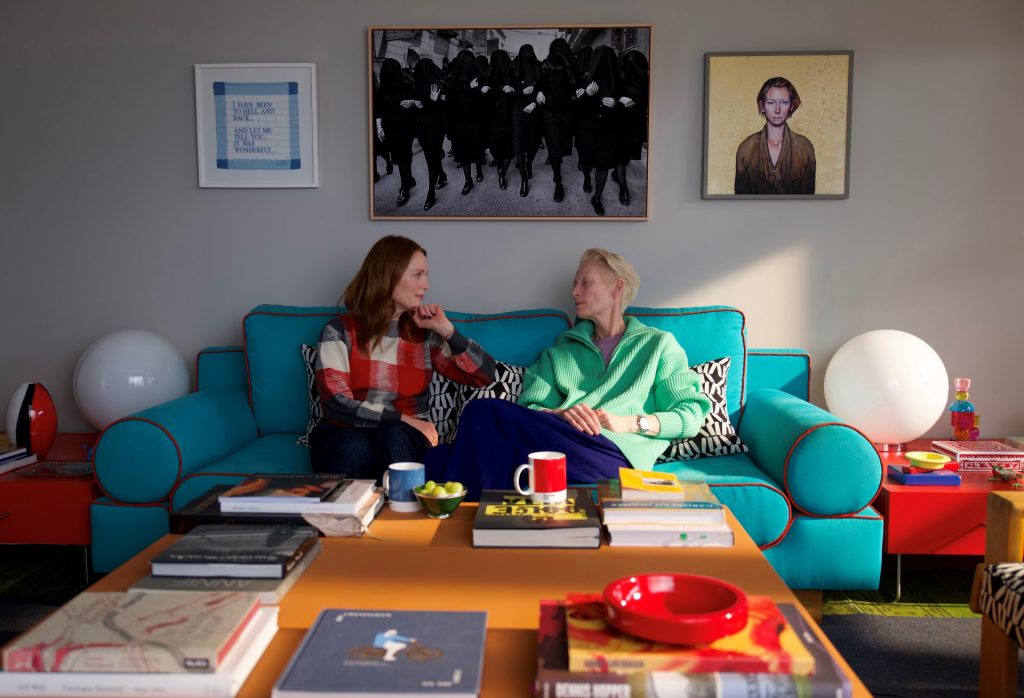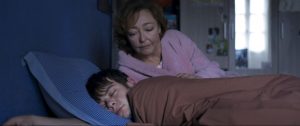An interview with Paying for It writer/director Sook-Yin Lee on adapting Chester Brown’s graphic novel and bringing their relationship to the screen.
TFCA Friday: Week of January 10
January 10, 2025

Welcome to TFCA Friday, a weekly round-up of film reviews and articles by TFCA members.
In Release this Week
Ad Vitam (dir. Rudolph Lauga)
“If the pilot sounds something like Taken, the film is sort of Taken, French style with paragliding and a few other high suspense additions added into the plot. The film can be described as the typical suspense thriller, French style, though it contains a few fillers to make the running time stretch to 90 minutes,” says Gilbert Seah at Afro Toronto. “A nice take is that Leo, his wife is also trained as GIGN and is a fitting kick-ass female, rather than a damsel in distress. Overall, it was an ok watch!”
Better Man (dir. Michael Gracey)
“It seems contradictory, yet it appears it’s possible for a film to be both wildly adventurous and maddeningly formulaic at the same time. Witness Better Man, the heavily effects-driven biopic of British pop star Robbie Williams which possesses something of a split personality,” says Kim Hughes at Original Cin. On one hand, its chief conceit is commendably weird: the adult Williams is played by Jonno Davies as a chimpanzee filmed in motion capture, conjured with CGI to humanoid effect, and voiced by its subject. Daring! Yet its story follows a ho-hum biopic trajectory structurally indistinguishable from recent entries such as Rocketman and Bohemian Rhapsody.”
Den of Thieves 2: Pantera (dir. Christian Gudegast)
“Butler and O’Shea give it their all, but only Superman could turn this script (co-written by Gudegast) from coal into a diamond. Among the odd asides is one in which Nick explains that the only reason robberies are so lucrative is because of the time and energy expended by authorities to prevent it, which makes less than no sense. It sounds like a defund-the-police rant from a five-year-old,” notes Chris Knight at Original Cin. “Sorry to have to add this, but Den of Thieves 2: Pantera concludes on a note that could ultimately lead to yet another sequel. So, stay tuned in 2032 or thereabouts for Den of Thieves 3: Éspace. Butler will be in his sixties by then, and perhaps looking for a Liam Neeson-type action role. You’ve been warned.”
“It’s one of those rare cinematic moments that you don’t always see coming, but Den of Thieves 2: Pantera is actually one of those rare sequels that surpasses the original in every way as we get to see more into the mindset of the characters and what it takes to live on that thin line between cop and crook, while trading in the concrete jungle of Los Angeles for the south of France,” writes Dave Voigt at In the Seats. “Returning as the embattled and ethically questionable Big Nick, our action hero of the B-Movie modern age in Gerard Butler is actually beginning to find his inner Al Pacino.”
“Den of Thieves 2: Pantera with its larger budget could have been a much better film given a better-written and credible script despite a few impressive action set pieces,” admits Gilbert Seah at Afro Toronto.
“[I]n the cold and allegedly cruel days of January, 2025, Gudegast has miraculously brought the gang back together for Den of Thieves 2: Pantera – no mean feat of reassembly given the first movie killed almost all the characters off except for Big Nick and Donnie,” says Barry Hertz at The Globe and Mail. “But who needs such initial stars as Pablo Schreiber and Curtis ’50 Cent’ Jackson when you’ve got all the big beefy boys you could possibly ask for in Butler and Jackson, who relocate to the Côte d’Azur for this trashy-but-taut exercise in turned tables and changed games.” Hertz also speaks with stars Gerard Butler and O’Shea Jackson about the franchise’s artistic merits: “I always believed in the pedigree of the writing and that it had fascinating characters and a whole world represented,” says Butler. “And when we finally got the movie into something quantifiable, I didn’t feel it was particularly sold in the right way. It was more elevated and clever than perhaps it was given credit for.”
Diane Warren: Relentless (dir. Bess Kargman)
“Diane Warren: Relentless offers an engaging spin on the music doc as it looks at the life and career of a woman who wrote many of the hits that topped the charts, made movie magic, and pulled on heartstrings for years,” writes Pat Mullen at POV Magazine. “Too few documentaries provide insight into the idiosyncrasies of below the line talents, but few of such figures have the level of celebrity that might easily inspire a doc like Warren does.”
Disco’s Revenge (dir. Omar Majeed, Peter Mishara 🇨🇦)
“At best, the doc captures the soaring spirit of the oneness and rhythm of the unforgettable sound of disco, bringing back fond memories of an era often clouded by prejudice and hate for things unknown,” writes Gilbert Seah at Afro Toronto.
“It is a pulsating deep dive into the very soul of disco music and its enduring impact across genres and history, told by the people who created it, nurtured it, and in turn, discovered themselves on the dancefloor. The film asks: Why does disco matter and, in these divisive times, why does disco matter now more than ever?” asks Dave Voigt at In the Seats with… Voigt speaks with directors Omar Majeed and Peter Mishara about their doc and why disco will never die.
“Love disco or hate it, the exhilarating documentary on the dance craze that rocked the world in the 70s is pure joy! Disco’s Revenge from writer directors Peter Mishara and Omar Majeed dives into the music dance craze that dominated the 70s,” observes Anne Brodie at What She Said. “Interviews with celebs of the day including Nile Rodgers, Jellybean Benítez, Billy Porter puts the lifestyle in context, New York in the 70’s, AIDs, gay and women’s liberation, a time of buzzing cultural upheaval.”
Nickel Boys (dir. RaMell Ross)
***Winners: 3 TFCA Awards including Best Picture***
“It’s only fair to warn that Ross’s avant-garde style makes the film far more challenging to view. Not everyone will love it. Some will object that the film would work better if rendered in a more conventional manner,” notes Marc Glassman at Classical FM. “I disagree and so do most critics. Ross has taken a risk, yes, but he’s been successful because his artistic approach forces to look at a situation that we all know too well—the miseries that the white Southerners visited on their Black brethren for over a century—with fresh eyes. In Nickel Boys, we are gifted a fresh and worthy perspective on a tragedy that should never get old.”
Omar and Cedric: If This Ever Gets Weird (dir. Nicolas Jack Davies)
“For those unfamiliar with the band there’s a decent chance you’ll find something appealing in the duo’s wide-ranging musical oeuvre,” writes Liam Lacey at Original Cin. “The earliest At The Drive-In music was hardcore punk inspired, involving lots of shuddering rhythms, and the kind of squalling guitar and yowling vocals that brings to mind a sack of cats going through a wood-chipper. But the duo’s musical style changed and expanded and grew easier on the ears.”
“[T]he finer points of If This Ever Gets Weird simply get diluted amid the sea of material. The musicians tell their story at a relatively glacial pace. Covering every breakthrough, fight, and acid trip yields a thorough portrait, but also an exhausting one. Moreover, the nature of the archival material—videos shot by a young adult on consumer cameras—means that the feature is inevitably rough by design, especially during the friends’ drug-fuelled adolescence,” says Pat Mullen at POV Magazine. “It demands a lot along such a long, meandering journey. Fans will probably love the unconventionally intimate glimpse, but others may struggle to take much away from it. Sorry guys, but it gets weird.”
The Room Next Door (dir. Pedro Almodóvar)
“Swinton’s Martha is alternately upbeat and sardonic — ‘I swing between euphoria and depression’ — while Moore’s Ingrid is a steadying influence who hides her terror over what’s to come as she quickly falls back into best friend mode,” writes Peter Howell at the Toronto Star. “Almodóvar loosely adapted his screenplay from the 2020 novel What Are You Going Through by Sigrid Nunez. He has a neat way of illustrating the author’s penchant for referencing other art forms, in particular works of literature.”
“With few of the melodramatic flourishes for which Almodóvar is renowned, The Room Next Door is a contemplative film that, after a bumpy introductory act, progresses to a cathartic meditation on friendship and the possibilities of finding moments of joy under a cloud of tragedy,” says Liam Lacey at Original Cin. “While the stories reveal the women’s worldliness and refined taste, the dialogue feels less like conversation than chunks of prose read aloud. As a side note, Nunez’s novel may have been inspired by her friendship with Susan Sontag whose book, Illness as Metaphor, could be the direct source for Martha’s rants about the stigmatizing language people use to talk about cancer.”
“Moore and Swinton play off each other beautifully throughout the film. Shorter, feistier and quintessentially American, Moore is the kind of BFF anyone would want: caring, compassionate, charismatic,” notes Marc Glassman at Classical FM. “The aristocratic Swinton is the perfect Brit—or Scot: angular, elusive, on a final quest. You don’t have to imagine sex between them to understand that they complete each other emotionally and philosophically.”
“Things continue to go dark at the rental, Martha’s shock and anger at her illness consume her while Ingrid ponders her legal status as she helps with euthanasia,” adds Anne Brodie at What She Said. “This is strong stuff, painfully real and maybe not for certain audiences, but its also strangely comforting watching two people traverse what so many in this world do. Very strong stuff.”
“Yet not even an iconic aesthete such as Almodóvar’s can run away from the fact that his first full-length English-language screenplay plays it all far too straight,” notes Barry Hertz at The Globe and Mail. “Moore and Swinton –alongside brief supporting turns from John Turturro as Ingrid (and Martha’s) former lover, and Alessandro Nivola as a righteous cop – do their very best to take Almodóvar’s clunky, start-and-stop dialogue and turn it into something resembling actual human conversation. But ultimately, it all becomes too strained to take seriously.”
“Martha’s intuitive word choices are among the many literary highlights of The Room Next Door. The film is remarkably attuned to language as Almodóvar’s first English-language feature. (He previously made the English short Strange Way of Life, too.) The Spanish director adapts Sigrid Nunez’s novel What Are You Going Through and delivers one of his talkiest films outside his native tongue,” says Pat Mullen at That Shelf. “This gift for gab often proves an under-valued trademark of his work, which fans often overlook in praise of his visual style. The guy literally won an Oscar for writing a movie called Talk to Her, but this play on women talking is one of Almodóvar’s better feats as a screenwriter.”
The Seed of the Sacred Fig (dir. Mohammed Rasoulof)
“Tension soar as he seeks to find out who is lying, who took it? In a fury he takes them to an isolated cave to get the truth out of them,” writes Anne Brodie at What She Said. “The nearly three-hour length goes by like that – superb performances, excellent depictions of western ways threatening traditional ways, the divides in Iran, generational, political and personal and what happens when a family falls to pieces. It will leave you breathless.”
“The search for the missing gun, the most loaded of metaphors, becomes the catalyst for the second half of this carefully paced film, which transforms into a pulse-pounding thriller as paranoia runs rampant,” says Peter Howell at the Toronto Star. “In the end, The Seed of the Sacred Fig offers a chilling reminder that in a society where trust is the scarcest of resources, the most dangerous weapon may be the secret doubts that germinate in the heart of a true believer.”
“Filled with relatable family drama and political tension so palpable you could cut it with a knife and even at a herculean run time of 2hr and 46 min, The Seed of the Sacred Fig is hard to look away from,” says Dave Voigt at In the Seats with…Voigt also speaks with director Mohammed Rasoulof about shooting the film in secret.
“The social and family drama works well in a gripping dramatic account but when it turns to a cat-and-mouse thriller at the end, the transition does not really work,” observes Gilbert Seah at Afro Toronto. “Still – the winner of the Special Jury Prize at the 2024 Cannes Film Festival.”
On the TFCA blog, Marriska Fernandes chats with Rasoulof about filmmaking and freedom. “The many dealings I had with people who were in the Iranian regime [started] over many years with people working in the censorship apparatus, but then those working in the security apparatus like interrogators, and then those working in the judiciary, so prosecutors and judges,” says Rasoulof. “This chain of people and mutual relationships between them and me led me to think a lot about their common trait, which was [to] hand over to someone else who will think for you, but also take decisions for you so we could translate it as submission to power or to ideology. That was a very important point for me and it is really the backbone of the film, the central issue of the film.”
Young Werther (dir. José Lourenço 🇨🇦)
“For the few who bothered to read the book, breathe a sigh of (relatively) spoiler-free relief: Lourenço uses the source material as little more than a light frame to hang his new characters…Instead of the self-pitying melancholy that caused media-inspired copycat suicides to be referred to as ‘the Werther effect,’ there is at least the nugget of self-awareness in Young Werther. The tone is indeed lighter: a kind of depressed, Technicolor twee that Canada may soon find itself defined by, given both this and Bilal Baig’s phenomenal Sort Of,” writes Jackson Weaver at CBC. “But more importantly, Lourenço doesn’t let Werther off the hook — a refreshing turn from a lazy writerly habit.”
“I wonder what Goethe would think of José Lourenço’s Young Werther, an odd, whimsical adaptation of the German writer’s first novel, the 1774 tragic romance?” asks Anne Brodie at What She Said. “Johann Wolfgang von Goethe was a renowned polymath – poet, playwright, novelist, scientist, statesman, theatre director, and critic – who might have scratched his head at it and present-day Toronto, plainly identifiable as its wonderful, unique self.”
“Long underutilized and certainly undervalued, Canadian actress Pill is a pure delight here as Charlotte, anchoring and then elevating every single scene that she is in. Her character is a tricky one to nail – especially as she grows closer to the frequently frustrating Werther, at the expense of her altogether respectable beau Albert,” says Barry Hertz at The Globe and Mail. “Yet Pill ensures that Charlotte never falls into any one of the story’s out-in-the-open traps – nor does the actress’s fellow Canadian Adams, with the Suits veteran providing the charm offensive that Booth is supposed to be armed with. And further in the margins, Iris Apatow (younger daughter of comedy mogul Judd) is so charming as Charlotte’s younger sister that she slams shut the nepo-baby argument before it even begins.”
“The film doubles down on the Goethe connection with an opening crawl that compares the 18th century reaction to the author’s novel with Beatlemania, the better to whet your appetite for the story that follows,” adds Jim Slotek at Original Cin. “Said story is love-at-first-sight, as experienced by Werther (Douglas Booth), a man with an iron whim. Werther’s delusional impulses and bad ideas are certified as such by his pessimistically pragmatic best friend Paul (Jaouhar Ben Ayed). But the notion that Werther has fallen under a magic spell from afar by a random woman he doesn’t even know (Charlotte, played by Alison Pill) suggests that this love is a creation of his own mind.”
File Under Miscellaneous
Fresh off his wins for Best Director and Best Picture at the Golden Globes, Brady Corbet shares his approach to The Brutalist with Peter Howell at the Toronto Star: “I have a very queasy, uneasy relationship with history and how it’s gotten us to where we are today,” says Corbet on the upside-down shot of the Statue of Liberty that opens the film. “And so the camerawork in Childhood of a Leader and Vox Lux and this film speaks to the nauseating, dizzying, uncanny nature of historical events. It’s funny because when we were shooting it, it just felt right.”
On In the Seats with…, Dave Voigt chats with Allan Hawco and Josephine Jobert about their new CBC series Saint-Pierre.
At POV Magazine, Pat Mullen chats with Eno director Gary Hustwit about making a “generative” documentary about Brian Eno that’s different each time it plays and learns what distinguishes his approach from artificial intelligence. “We brought our intelligence as filmmakers and storytellers into the algorithms,” says Hustwit. “You can make your own generative software that uses all of your own material—that is 100% ethical. It’s just a tool that we’re using to remix the story in interesting ways, so there’s a big distinction there.”
TV Talk/Series Stuff
At What She Said, Anne Brodie salutes Vera upon its finale: “There’s a fun tribute to Vera in the name of a pub where the team goes – without her – for a brew. And we see her for the first time as a young girl who dreams of being in the police despite her father’s strong discouragement. Production values remain extremely high. The cinematography interprets the harsh seaside Northumberland UK landscape as Vera’s equal in power and judicious editing allows us to pause on a scene as long as we need to extract its goodness. A marvel. And a satisfying closer. So long, Vera/Brenda. Thank you!” However, some new and British can be found in Missing: “We all know how masterful British drama is and this one certainly is, and runs high in the jolts-per-second manner.” Meanwhile, North of North boasts “a great soundtrack with music from indigenous artists.”



